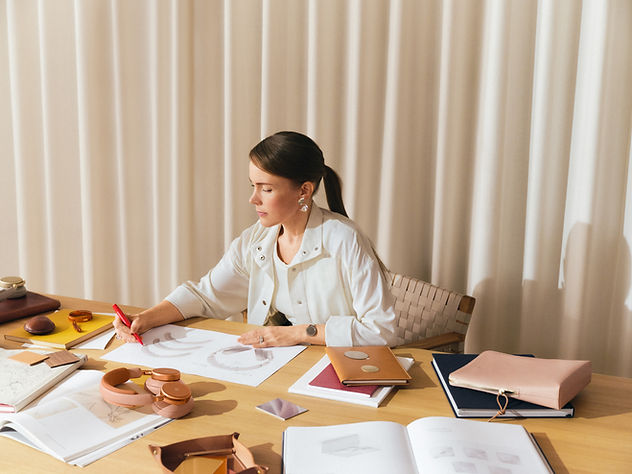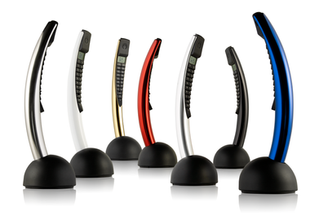
July 12, 2025 | PEOPLE
the SHAPE of SOUND to COME
words Onur Basturk
Bang & Olufsen has never been just another electronics brand. For over a century, it’s redefined the boundaries between sound and sculpture, technology and emotion. As the industry moves toward sustainability and more personal experiences, B&O stays ahead by doing what it does best—challenging norms. In this conversation, Head of Design Tiina Karjalainen Kierysch shares her thoughts on legacy, longevity, and why emotion might just be tech’s most powerful feature.

Bang & Olufsen’s design language has evolved over the years, yet the core idea of “timeless aesthetics” remains constant. How do you balance this legacy with innovative design decisions?
A huge part of our legacy is the mindset behind how we create products rather than the aesthetics themselves. What sets Bang & Olufsen apart from the general consumer-electronics industry is that we have always done things differently. Being unconventional is practically part of our DNA. Our products not only look different, but they also function and interact very differently from many competing products. As a designer, being able to challenge the status quo is liberating and offers a huge opportunity to explore completely new archetypes—rethinking use cases, shapes, interactions, and tactility. We even go so far as to change the meaning of entire product categories from time to time. For example, in the 1990s we transformed CD players from black plastic boxes into beautiful glass displays that could create an entire evening playlist for you. Another example is Beosound Shape, where we re-contextualised a speaker as an art piece on the wall—we often see things differently. Our founders, Peter Bang and Sven Olufsen, had a mission: “a never-failing will to create only the best, continuing to find new ways and improvements.” One hundred years later, we carry this legacy forward by continuing to challenge the status quo and keeping an open mind toward evolving creation, technologies, and manufacturing processes. 2. In new products like the Beoplay H100, elements such as modularity and reparability are emphasised.
How early do these sustainability-focused decisions enter your design process?
Our teams design in a modular way, and this is built in from the very beginning of the process so that parts can be repaired or exchanged later in their lifetimes. When new technologies emerge, products can also be upgraded through software. The modular-design expectations and targets we set for ourselves are challenging, yet they make the teams highly motivated. When it comes to sustainability, we work with the Cradle to Cradle certification, which provides a framework for assessing circularity and sustainability performance. Another approach to longevity is repurchasing old products, restoring them, and making them compatible with modern technology—we call these our Recreated Classics. We need to work together as an industry and solve the problems we can only solve collectively, using technological advancements to drive positive change and a culture of circularity. We strive to learn and improve constantly in this field while inspiring others to join the movement.
I’M FASCINATED BY NEW SENSORY EXPERIENCES—ESPECIALLY THOSE INVOLVING TACTILITY, MOVEMENT, OR SOUND
You’re leading the reimagining of iconic B&O products from the past. What is the biggest challenge in these redesign processes—staying true to the original form, integrating new technologies, or adapting to today’s user habits?
Reintroducing products from the past gives us an opportunity to highlight, celebrate, and bring back some of our most iconic designs. These designs are icons for a reason, so when considering any updates we approach them very carefully, protecting their design integrity. We look at whether there are elements to improve, how colours and materials can fit into a contemporary context, and how we can connect yesterday’s interfaces to future user experiences seamlessly.
You’ve worked across a wide range of sectors—from industrial products to transportation design. How have these cross-disciplinary experiences influenced your approach at Bang & Olufsen?
Each sector I’ve worked in has brought specific lessons, especially regarding processes. I’ve learned a great deal from the clarity of product-development structures in transportation design and from the importance of innovation processes within craft in the fashion and luxury industries. Most of my experience has also been in international settings—Europe, the US, and Asia—which has given me invaluable cultural insights. From this mix of influences, I’ve distilled best practices and, most importantly, a mindset that guides everything I do.
I’m a designer and design leader who believes in the power of creativity and people. When exploring future ideas and solutions, I aim for a better world—one that needs more collaboration and a more sustainable tomorrow. I find joy in building teams that strive toward that goal through design excellence and care.
What does good design mean to you? How would you describe your relationship with sensory elements like sound, form, and tactility?
A product must be well-made and well thought-through—a great fit for your life that provides beautiful solutions. As designers, we have an important responsibility to push the boundaries of circularity when developing products. Design is a universal language. Through a product’s design, we visually communicate with potential customers and users, not only through its shapes or colours but also through the way it feels, sounds, and interacts with you. Great designs are often founded on unique ideas; they are memorable and leave a lasting impression. I think a product should move you—delight you, inspire you, or spark your curiosity. Sound, form, and tactility play a huge role in that emotional impact. Products stand out to me when I can recall how they looked or felt. I’m intrigued by how design triggers emotions and by the magic that happens when technology meets art and imagination. New experiences also fascinate me—things I’ve never encountered before that engage the senses with tactility, movement, or sound. I’m drawn to products created in remarkable ways, where you can feel the care for design excellence. When a product makes sense both rationally and emotionally—and gives you an overwhelming feeling of excitement—you feel the true strength, value, and power of design.

MAGIC HAPPENS WHEN WE ENTER A JOINT CREATIVE FLOW
You’ve said that sustainability is not just about materials but about building long-term emotional connections with users. Can you share an example where this idea shaped a project?
Listening to music is an emotional experience. Bringing back memories from the 1990s with a refurbished Beosound 9000c connected to modern speakers and an app adds another emotional layer—memories come alive again in a future format. Aside from the Beosound 9000c, our Recreated Classics programme has introduced the Beogram 4000c record player and, more recently, the Beogram 3000c, revitalising classic Bang & Olufsen listening experiences. We want our products to be investments—objects that can be passed on to the next generation. In a world where consumer-electronics products can become obsolete quickly, we ensure they can be updated over time, with both hardware and software. Our products are designed modularly so that parts can be repaired or exchanged when needed. Together with our customers, we also create personalised products through our Atelier programme, where colours, materials, and finishes can be customised. Emotional connections often become even stronger when you, as the customer, help design the final result.
What motivates you most during the design process—silence or sound? What kind of environments fuel your creativity?
A huge source of inspiration is the teams I work with. Magic happens when we enter a joint creative flow. Through deep collaboration and by leveraging everyone’s expertise, we can conceptualise and design products we would never have imagined on our own. Being inspired by each other’s creative minds makes me forget time and space and dive into new imaginative worlds. Sound often inspires us in the studio when we create together, while silence is equally important for diving deeply into individual imagination and thought.
What advice would you give to young designers—especially those looking to balance technology, craftsmanship, and emotional resonance in their work?
Always remember that your individual contribution is unique. Nobody else will approach a design exactly the way you do. Identify your distinctive characteristics as a designer and use your personality to bring unique value to every design conversation. Stay curious and keep an open mindset for learning new things, perspectives, and methods. It will enrich you and your creativity, and you’ll enjoy your journey as a designer. At the same time, you’ll energise those around you. Dare to propose unusual, even crazy ideas—designers always have the power to propose. And remember to have fun!

















